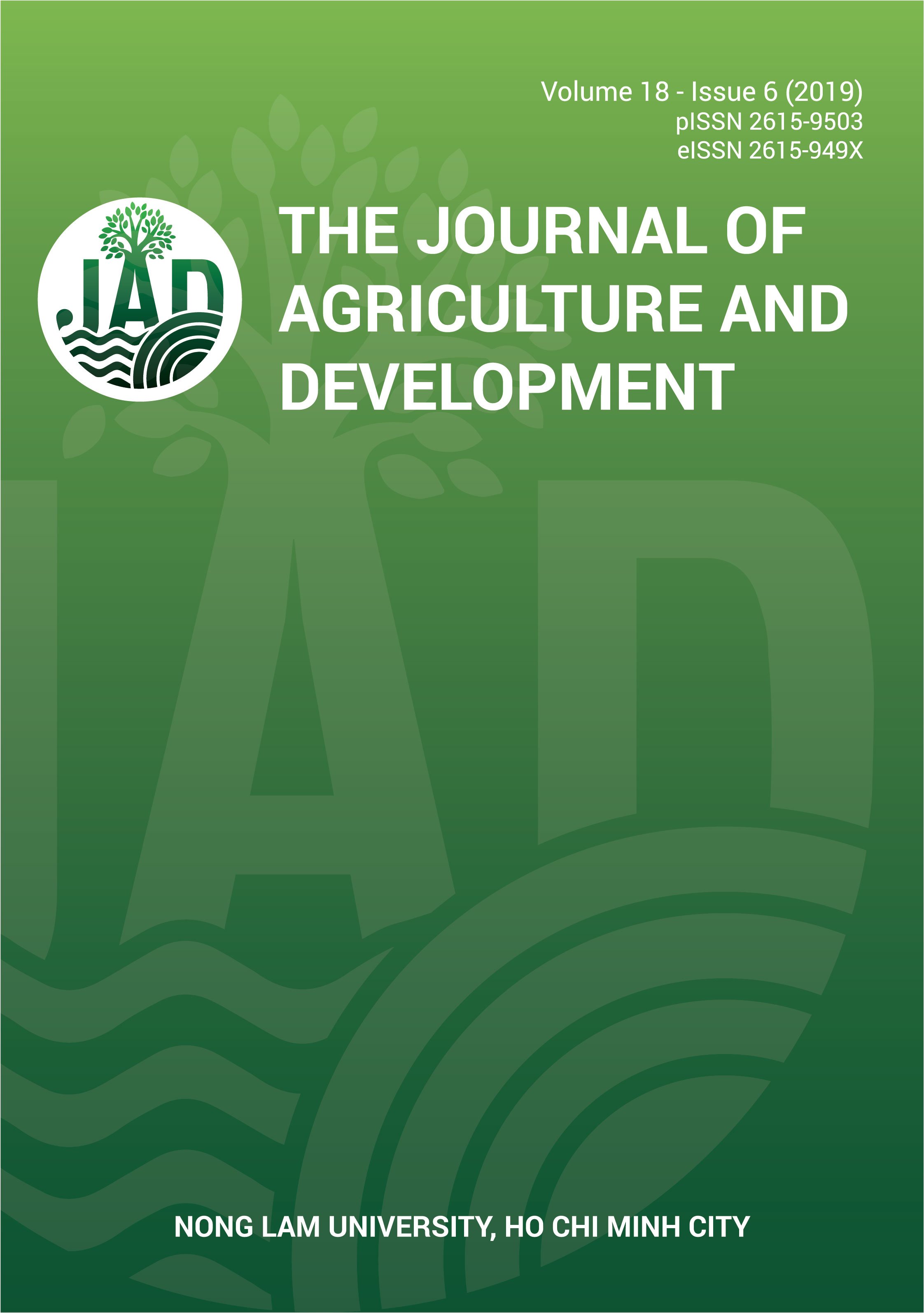Spray-drying microencapsulation of β-carotene by polysaccharide from yeast cell walls
Main Article Content
Abstract
It is well known that β-carotene plays an important role in human health. However, it is susceptibly degraded by environmental conditions including temperature, light and oxygen, due to its natural structure of conjugated double bonds chain. Polysaccharide (PS) from the yeast cell walls has appeared to be an excellent choice of encapsulating agent that can be used to encapsulate biologically active substances. Objective of this study was to investigate the effects of PS concentration (20, 30, 40 and 50%) compared to MD, high pressure homogenization time (5, 10, 15, 20 min) and inlet air temperature of spray drying (130, 140, 150, 160°C) on microencapsulation yield (MEY), microencapsulation efficiency (MEE), moisture content (MC) and antioxidant capacity. The results showed that the highest values of MEY (354.4 µg/g) and MEE (90.2%), the low value of MC (7.0%) and antioxidant capacity (69.07%) were successfully obtained at PS concentration of 30% (w/v), homogenization of 15 min and inlet air temperature of 150°C. Under those conditions, the encapsulated β-carotene powder was examined by scanning electron microscopy (SEM) and it is confirmed that the microparticles had various sizes which are a typical characteristics of spray dried powders, spherical shapes and were free of cracks and pores. As a result, it can be concluded that β-carotene was successfully encapsulated in the PS and MD matrix and could then be easily incorporated into various foods.
Article Details
References
Brand-Williams, W., Cuvelier, M. E., & Berset, C. (1995). Use of a free radical method to evaluate antioxidant activity. LWT-Food science and Technology 28(1), 25-30. https://doi.org/10.1016/S0023-6438(95)80008-5
Bzducha-Wr´obel, A., Blaz˙ejak, S., Kawarska, A., Stasiak-R´oz˙an´ska, L., Gientka, I., & Majewska, E. (2014). Evaluation of the efficiency of different disruption methods on yeast cell wall preparation for β-glucan isolation. Molecules 19(12), 20941-20961. https://doi.org/10.3390/molecules191220941
Czerniak, A., Kubiak, P., Bialas, W., & Jankowski, T. (2015). Improvement of oxidative stability of menhaden fish oil by microencapsulation within biocapsules formed of yeast cells. Journal of Food Engineering 167(part A), 2-11. https://doi.org/10.1016/j.jfoodeng.2015.01.002
Gharsallaoui, A., Roudaut, G., Chambin, O., Voilley, A., & Saurel, R. (2007). Applications of spray-drying in microencapsulation of food ingredients: An overview. Food Research International 40(9), 1107-1121. https://doi.org/10.1016/j.foodres.2007.07.004
Golovina, E. A., Golovin, A., Hoekstra, F., & Faller, R. (2010). Water replacement hypothesis in atomic details: effect of trehalose on the structure of single dehydrated POPC bilayers. Langmuir 26(13), 11118-11126. https://doi.org/10.1021/la100891x
Kha, T. C., Nguyen, M. H., & Roach, P. D. (2010). Effects of spray drying conditions on the physicochemical and antioxidant properties of the Gac (Momordica cochinchinensis) fruit aril powder. Journal of Food Engineering 98(3), 385-392. https://doi.org/10.1016/j.jfoodeng.2010.01.016
Kha, T. C., Nguyen, M. H., Roach, P. D., & Stathopoulos, C. E. (2014). Microencapsulation of Gac oil: Optimisation of spray drying conditions using response surface methodology. Powder Technology 264, 298-309. https://doi.org/10.1016/j.powtec.2014.05.053
Kogan, G., & Kocher, A. (2007). Role of yeast cell wall polysaccharides in pig nutrition and health protection. Livestock Science 109(1-3), 161-165. https://doi.org/10.1016/j.livsci.2007.01.134
Loksuwan, J. (2007). Characteristics of microencapsulated β-carotene formed by spray drying with modified tapioca starch, native tapioca starch and maltodextrin. Food Hydrocolloids 21(5-6), 928-935. https://doi.org/10.1016/j.foodhyd.2006.10.011
Nazzaro, F., Orlando, P., Fratianni, F., & Coppola, R. (2012). Microencapsulation in food science and biotechnology. Current Opinion in Biotechnology 23(2), 182-186. https://doi.org/10.1016/j.copbio.2011.10.001
Paramera, E. I., Konteles, S. J., & Karathanos, V. T. (2011). Microencapsulation of curcumin in cells of Saccharomyces cerevisiae. Food Chemistry 125(3), 892-902. https://doi.org/10.1016/j.foodchem.2010.09.063
Pham-Hoang, B. N., Romero-Guido, C., Phan-Thi, H., & Wach´e, Y. (2018). Strategies to improve carotene entry into cells of Yarrowia lipolytica in a goal of encapsulation. Journal of Food Engineering 224, 88-94. https://doi.org/10.1016/j.jfoodeng.2017.12.029
Rodriguez-Amaya, D. B. (2001). A guide to carotenoid analysis in foods. Washington, USA: ILSI press Washington.
Shappley, Z. W., Jenkins, J. N., Zhu, J., & McCarty Jr., J. C. (1998). Quantitative trait loci associated with agronomic and fiber traits of upland cotton. The Journal of Cotton Science 2, 153-163.
Shi, G., Rao, L., Yu, H., Xiang, H., Yang, H., & Ji, R. (2008). Stabilization and encapsulation of photosensitive resveratrol within yeast cell. International Journal of Pharmaceutics 349(1-2), 83-93. https://doi.org/10.1016/j.ijpharm.2007.07.044
Shu, B., Yu, W., Zhao, Y., & Liu, X. (2006). Study on microencapsulation of lycopene by spray-drying. Journal of Food Engineering 76(4), 664-669. https://doi.org/10.1016/j.jfoodeng.2005.05.062
Sultana, A., Tanaka, Y., Fushimi, Y., & Yoshii, H. (2018). Stability and release behavior of encapsulated flavor from spray-dried Saccharomyces cerevisiae and maltodextrin powder. Food Research International 106, 809-816. https://doi.org/10.1016/j.foodres.2018.01.059
Sun-Waterhouse, D., Penin-Peyta, L., Wadhwa, S. S., & Waterhouse, G. I. N. (2011). Storage stability of phenolic-fortified avocado oil encapsulated using different polymer formulations and co-extrusion technology. Food and Bioprocess Technology 5(8), 3090-3102. https://doi.org/10.1007/s11947-011-0591-x
Tonon, R. V., Brabet, C., & Hubinger, M. D. (2008). Influence of process conditions on the physicochemical properties of a¸cai (Euterpe oleraceae Mart.) powder produced by spray drying. Journal of Food Engineering 88(3), 411-418. https://doi.org/10.1016/j.jfoodeng.2008.02.029
Wagner, L. A., & Warthesen, J. J. (1995). Stability of spray-dried encapsulated carrot carotenes. Journal of Food Science 60(5), 1048-1053. https://doi.org/10.1111/j.1365-2621.1995.tb06290.x
Ye, X., Al-Babili, S., Kl¨oti, A., Zhang, J., Lucca, P., Beyer, P., & Potrykus, I. (2000). Engineering the provitamin A (β-carotene) biosynthetic pathway into (carotenoid-free) rice endosperm. Science 287(5451), 303-305. https://doi.org/10.1126/science.287.5451.303








